Overview
- Brief Narrative
- Łódź (Litzmannstadt) ghetto scrip, 5 mark note, acquired by Benjamin Miedzyrzecki, who lived in Łódź, Poland, circa February-May 1945, after leaving Warsaw following the liberation of both cities in early 1945. Scrip was issued by the Jewish Council as payment for work or as subsidy in the German-controlled ghetto from May 15, 1940 until the ghetto was liquidated in spring 1944. Benjamin, his parents Israel and Rivka, and siblings Stela, Mordecai, and Genia lived in Warsaw during the German occupation which began in September 1939. Benjamin escaped to eastern Poland, then returned in December and joined the resistance. They were forced into the Jewish ghetto in October 1940, and Benjamin was a forced laborer, working outside the ghetto cleaning destroyed buildings. He smuggled people in and out of the ghetto for the resistance. In July 1942, the Germans began mass deportations of Jews to Treblinka killing center. Israel was arrested and bribed a policeman to release him. Stela and her husband Yitzhak Blachowicz were sent to Treblinka. In fall 1942, Benjamin meet Feigele (Vladka) Peltel, a courier for the underground, when he smuggled her out of the ghetto. They went into hiding on the Aryan side of Warsaw. He persuaded his family to join him. In summer 1943, Mordecai was killed by the Germans. The ghetto was liquidated that summer after the failed Warsaw Ghetto Uprising. In August 1944, Soviet troops reached the Vistula River near Warsaw and the Polish Home Army rebelled against the German occupation. Israel, Rivka, and Genia were separated from Benjamin. The Uprising was crushed and the city destroyed by the Germans in October 1944. Benjamin was reunited with his family after Warsaw was liberated on January 16, 1945.They lived in Warsaw, where Israel insisted that Benjamin marry Feigele. The family went to Łódź and, after the war ended in early May 1945, left for Munich, Germany. In May 1946, Benjamin and Feigele sailed for America. Genia emigrated to Palestine in 1946 and Israel and Rivka joined her in 1947.
- Date
-
issue:
1940 May 15
found: approximately 1945 February
- Geography
-
issue:
Litzmannstadt-Getto (Łódź, Poland);
Łódź (Poland)
- Credit Line
- United States Holocaust Memorial Museum Collection, Gift of Benjamin Meed
- Markings
- face, upper right corner, printed, black ink : 5
face lower left corner, printed black and orange ink : 5
face, rectangle upper left corner, printed, black ink : Quittung / über [Receipt for]
face, center, printed, black and orange ink : Fünf Mark [Five Marks]
face, bottom, printed, black ink : Der Aelteste der Juden / in Litzmannstadt / M. Rumkowski / Litzmannstadt, den 15 Mai 1940 [Receipt for five marks / The Elder of the Jews in Litzmannstadt M. Rumkowski / Litzmannstadt, 15 May 1940]
reverse, upper left corner, printed black ink : Quittung über / Fünf Mark [Reciept for five marks]
reverse, bottom, printed, black ink : WER DIESE QUITTUNG VERFÄLSCHT ODER NACHMACHT ODER GEFÄLSCHTE / QUITTUNGEN IN VERKEHR BRINGT / WIRD STRENGSTENS BESTRAFT [Anyone who falsifies or copies this receipt, or traffics in counterfeit receipts, will be strictly punished]
reverse, lower right, printed, black and orange ink : 5 - Contributor
-
Subject:
Benjamin Meed
- Biography
-
Benjamin Miedzyrzecki was born on February 19, 1918, in Warsaw, Poland, to Israel and Rivka Rybak Miedzyrzecki. He had three siblings: Stela, born 1916; Mordecai, born 1922; and Genia, born May 21, 1934. Israel was born on February 13, 1892, and was a tanner. Rivka was born on May 30, 1896. They spoke Yiddish and Polish. Benjamin attended an Orthodox Hebrew school until fifth grade, then went to a public school, where he immersed himself in Polish culture and learned to speak flawless Polish. In 1939, Benjamin’s brother Mordecai planned to emigrate to the United States. Their parents were ashamed that Mordecai would leave and asked him to stay, so he did.
On September 1, 1939, Germany invaded Poland. Warsaw resisted occupation and Benjamin made barricades in the streets. On September 29, German troops entered Warsaw. The German soldiers gave bread to Polish people, but pushed Jews away. They gave Benjamin bread because with his light hair and blue eyes, he did not appear Jewish. Around October, Benjamin and a friend fled to Bialystok, then Brest-Litovsk (Brest, Belarus). His friend wanted to go home, so they returned to Warsaw in December. In early 1940, Benjamin joined the underground resistance. He was in a group of six that operated an illegal library. The ghetto was established on October 12, 1940, and sealed in November. Benjamin’s apartment was already located in the ghetto and several people moved in with them. The ghetto was overcrowded and they had very little food. Benjamin arranged a school for the children in his building and taught at night. In late 1940, Benjamin became a forced laborer. He left the ghetto every day to pick up bricks from destroyed buildings. Benjamin took clothing out of the ghetto and traded it for food to bring back to his family. The resistance asked him to smuggle people in and out of the ghetto with the labor brigade. From July 22 to September 12, 1942, the Germans took thousands of Jews out of the ghetto. In September, Benjamin’s father Israel was arrested and taken to Umschlagplatz. Benjamin’s sister Stela, who worked as a secretary for a leader in the Judenrat (Jewish Council), tried to help him but was arrested with her husband Yitzhak Blachowicz and sent to Treblinka. Israel bribed a policeman and was let go. Following the mass deportations, the resistance asked Benjamin to build hiding places in the ghetto.
Later that fall, Benjamin met Feigele (Fajga) Peltel, called Vladka by the resistance. Feigele’s father died of pneumonia in the ghetto in 1941 and her mother, brother, and sister were deported in August 1942. She was a courier for the resistance and asked Benjamin to smuggle her out of the ghetto. He agreed, not knowing she was carrying a diagram of Treblinka. She was stopped and searched but was let go when someone else tried to run. In late 1942, Benjamin left the ghetto and stayed with a Polish woman named Juliana Larisz. He assumed the name Czeslaw Pankiewicz. He arranged to meet Feigele. The couple began dating, but had to keep their relationship a secret from the resistance. In late 1942, Benjamin convinced Israel, Rivka, and Genia to leave the ghetto with him and go into hiding. His brother Mordecai stayed, working for the Tobbens factory in the ghetto. In approximately January 1943, Mordecai was taken to Poniatowa, when the Tobbens factory was moved. A Polish woman helped Mordecai escape and join his family. Juliana helped Benjamin find a new hiding place for his family, in a goat shack in a cemetery in Praga, across the Vistula River.
After the mass deportations in summer 1942, people in the ghetto prepared to resist further deportations. Feigele purchased weapons and smuggled them into the ghetto. On April 19, 1943, the Warsaw Ghetto Uprising began. Armed Jews in the ghetto resisted deportations, but the Germans crushed the resistance and killed and deported thousands of Jews. Benjamin and other resistance members posted signs proclaiming solidarity with the fighters throughout Warsaw. Benjamin and his family witnessed the ghetto burning. The uprising ended on May 16 and the ghetto was left in ruins. In summer 1943, Benjamin acquired a false Latin American visa with the help of Israel and a family friend. Mordecai asked Benjamin to give him the document and he agreed. Mordecai disappeared and they learned he was shot. Benjamin continued to work for the resistance, building hiding places and waiting for Feigele to return from her daily courier missions.
On August 1, 1944, the Warsaw Uprising began. The Polish Home Army saw Soviet troops across the Vistula and rose against the Germans. Benjamin was afraid that his family would be killed if they remained in Praga, because the cemetery was located between 2 factories that he believed would be bombed. He moved them across the river to a new hiding place in Warsaw and left to be with Feigele. The Soviets advanced to the Vistula and liberated Praga, but did not cross the river into Warsaw, so the Uprising was crushed and Israel and his family were not liberated. Benjamin lost contact with his family. The wounded were being evacuated, so Benjamin bandaged his head and a Polish peasant took him and Feigele out of the city. They went to Pruszkow for a short time, then left to find a Jewish friend hiding on a farm near Kurczowa Wies. The estate had been taken over the German army, but they had false papers. In mid-January 1945, a member of the resistance told Benjamin that his family was in Opoczno and looking for him. On January 16, Benjamin and Feigele were liberated by Soviet troops in Kurczowa Wies.
Benjamin went to Opoczno and found his family. They returned to Warsaw, where Benjamin and Feigele were married. The family moved to Łódź and opened a leather store. The war ended when Germany surrendered on May 7, 1945. After hearing of renewed pogroms on Jews, Benjamin and Feigele decided to leave Poland, first to Belgium, then the US. In summer 1945, the couple was caught on the Belgian border by the British and imprisoned in Aachen. After a month, they were released by a British rabbi. They were very malnourished and were sent to recuperate in Garmisch-Partenkirchen. In August 1945, they moved to Munich and were joined by Benjamin’s family. On May 13, 1946, Benjamin and Feigele boarded the SS Marine Perch in Bremerhaven, arriving in New York on May 23. They settled in New York. Israel, Rivka, and Genia emigrated to Palestine in 1946. Feigele, who was famous for her activity in the resistance, wrote for a Jewish newspaper, The Forward. Benjamin opened an import-export business. They had two children. When they became naturalized American citizens in 1952, they changed their names to Benjamin and Vladka Meed. They were leaders in the survivor community and helped found the Warsaw Ghetto Resistance Organization, the World Gathering of Jewish Holocaust Survivors in Jerusalem, the American Gathering of Jewish Holocaust Survivors in DC, and the Registry of Jewish Holocaust Survivors. Benjamin helped found the United States Holocaust Memorial Museum and the Museum of Jewish Heritage. Benjamin, age 88, died on October 24, 2006, in New York. Vladka, age 90, died on November 21, 2010.
Physical Details
- Language
- German
- Classification
-
Exchange Media
- Category
-
Money
- Object Type
-
Scrip (aat)
- Physical Description
- Offwhite paper scrip printed in brown, green, black, and red ink. The face has a watermark with a latticework pattern in green ink. The serial number, 242583, in red ink is in the upper left corner. The denomination 5 is in the lower left corner in bold font and in the upper right in a black square. There is a 1.5 inch left margin, then a rectangle with a curved upper left corner with a background of interlocked Stars of David with a large Star of David in a circle in the upper left corner in brown ink. Across the center is the textual denomination in black ink with brown highlights and German text. The back has a blank 1.5 inch margin, then a rectangle with a pattern of interlocked Stars of David in brown ink. There is German text in the upper left corner and a 7-branched candelabrum in the lower left corner. The denomination 5 in bold font, black and brown ink, is outside the border at the lower left corner; above this, near the upper right corner, is a Star of David outline in a black square. The paper is discolored and creased. The scrip is torn in half and there is brown paper adhered to the back to hold it together.
- Dimensions
- overall: Height: 2.750 inches (6.985 cm) | Width: 5.000 inches (12.7 cm)
- Materials
- overall : paper, ink, adhesive
- Inscription
- face, upper left corner, stamped, red ink : No 242583
Rights & Restrictions
- Conditions on Access
- No restrictions on access
- Conditions on Use
- No restrictions on use
Keywords & Subjects
- Topical Term
- Holocaust, Jewish (1939-1945)--Poland--Warsaw--Personal narratives. Holocaust survivors--United States--Biography. Jews--Poland--Warsaw--Biography. World War, 1939-1945--Jewish resistance--Poland--Warsaw--Personal narratives. World War, 1939-1945--Underground movements--Poland--Warsaw--Personal narratives, Jewish.
- Geographic Name
- Poland--History--Occupation, 1939-1945--Biography.
- Personal Name
- Meed, Benjamin, 1918-2006.
Administrative Notes
- Legal Status
- Permanent Collection
- Provenance
- The scrip was donated to the United States Holocaust Memorial Museum in 1989 by Benjamin Meed.
- Funding Note
- The cataloging of this artifact has been supported by a grant from the Conference on Jewish Material Claims Against Germany.
- Record last modified:
- 2022-07-28 18:21:09
- This page:
- https://collections.ushmm.org/search/catalog/irn930
Download & Licensing
In-Person Research
- By Appointment
- Request 21 Days in Advance of Visit
- Plan a Research Visit
- Request to See This Object
Contact Us
Also in Benjamin Meed collection
The collection consists of ten pieces of Łódź (Litzmannstadt) ghetto scrip relating to the experiences of Benjamin Miedzyrzecki (later Benjamin Meed), when he lived in Łódź, Poland, after leaving liberated Warsaw, where he had been a resistance member in the ghetto and while living in hiding.
Date: approximately 1945 February
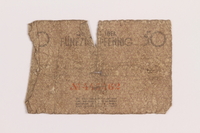
Łódź ghetto scrip, 50 pfennig note, acquired by a Polish Jewish survivor
Object
Łódź (Litzmannstadt) ghetto scrip, 50 pfennig note, acquired by Benjamin Miedzyrzecki, who lived in Łódź, Poland, circa February-May 1945, after leaving Warsaw following the liberation of both cities in early 1945. Scrip was issued by the Jewish Council as payment for work or as subsidy in the German-controlled ghetto from May 15, 1940 until the ghetto was liquidated in spring 1944. Benjamin, his parents Israel and Rivka, and siblings Stela, Mordecai, and Genia lived in Warsaw during the German occupation which began in September 1939. Benjamin escaped to eastern Poland, then returned in December and joined the resistance. They were forced into the Jewish ghetto in October 1940, and Benjamin was a forced laborer, working outside the ghetto cleaning destroyed buildings. He smuggled people in and out of the ghetto for the resistance. In July 1942, the Germans began mass deportations of Jews to Treblinka killing center. Israel was arrested and bribed a policeman to release him. Stela and her husband Yitzhak Blachowicz were sent to Treblinka. In fall 1942, Benjamin meet Feigele (Vladka) Peltel, a courier for the underground, when he smuggled her out of the ghetto. They went into hiding on the Aryan side of Warsaw. He persuaded his family to join him. In summer 1943, Mordecai was killed by the Germans. The ghetto was liquidated that summer after the failed Warsaw Ghetto Uprising. In August 1944, Soviet troops reached the Vistula River near Warsaw and the Polish Home Army rebelled against the German occupation. Israel, Rivka, and Genia were separated from Benjamin. The Uprising was crushed and the city destroyed by the Germans in October 1944. Benjamin was reunited with his family after Warsaw was liberated on January 16, 1945.They lived in Warsaw, where Israel insisted that Benjamin marry Feigele. The family went to Łódź and, after the war ended in early May 1945, left for Munich, Germany. In May 1946, Benjamin and Feigele sailed for America. Genia emigrated to Palestine in 1946 and Israel and Rivka joined her in 1947.
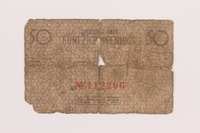
Łódź ghetto scrip, 50 pfennig note, acquired by a Polish Jewish survivor
Object
Łódź (Litzmannstadt) ghetto scrip, 50 pfennig note, acquired by Benjamin Miedzyrzecki, who lived in Łódź, Poland, circa February-May 1945, after leaving Warsaw following the liberation of both cities in early 1945. Scrip was issued by the Jewish Council as payment for work or as subsidy in the German-controlled ghetto from May 15, 1940 until the ghetto was liquidated in spring 1944. Benjamin, his parents Israel and Rivka, and siblings Stela, Mordecai, and Genia lived in Warsaw during the German occupation which began in September 1939. Benjamin escaped to eastern Poland, then returned in December and joined the resistance. They were forced into the Jewish ghetto in October 1940, and Benjamin was a forced laborer, working outside the ghetto cleaning destroyed buildings. He smuggled people in and out of the ghetto for the resistance. In July 1942, the Germans began mass deportations of Jews to Treblinka killing center. Israel was arrested and bribed a policeman to release him. Stela and her husband Yitzhak Blachowicz were sent to Treblinka. In fall 1942, Benjamin meet Feigele (Vladka) Peltel, a courier for the underground, when he smuggled her out of the ghetto. They went into hiding on the Aryan side of Warsaw. He persuaded his family to join him. In summer 1943, Mordecai was killed by the Germans. The ghetto was liquidated that summer after the failed Warsaw Ghetto Uprising. In August 1944, Soviet troops reached the Vistula River near Warsaw and the Polish Home Army rebelled against the German occupation. Israel, Rivka, and Genia were separated from Benjamin. The Uprising was crushed and the city destroyed by the Germans in October 1944. Benjamin was reunited with his family after Warsaw was liberated on January 16, 1945.They lived in Warsaw, where Israel insisted that Benjamin marry Feigele. The family went to Łódź and, after the war ended in early May 1945, left for Munich, Germany. In May 1946, Benjamin and Feigele sailed for America. Genia emigrated to Palestine in 1946 and Israel and Rivka joined her in 1947.
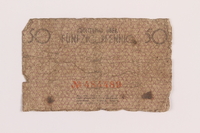
Łódź ghetto scrip, 50 pfennig note, acquired by a Polish Jewish survivor
Object
Łódź (Litzmannstadt) ghetto scrip, 50 pfennig note, acquired by Benjamin Miedzyrzecki, who lived in Łódź, Poland, circa February-May 1945, after leaving Warsaw following the liberation of both cities in early 1945. Scrip was issued by the Jewish Council as payment for work or as subsidy in the German-controlled ghetto from May 15, 1940 until the ghetto was liquidated in spring 1944. Benjamin, his parents Israel and Rivka, and siblings Stela, Mordecai, and Genia lived in Warsaw during the German occupation which began in September 1939. Benjamin escaped to eastern Poland, then returned in December and joined the resistance. They were forced into the Jewish ghetto in October 1940, and Benjamin was a forced laborer, working outside the ghetto cleaning destroyed buildings. He smuggled people in and out of the ghetto for the resistance. In July 1942, the Germans began mass deportations of Jews to Treblinka killing center. Israel was arrested and bribed a policeman to release him. Stela and her husband Yitzhak Blachowicz were sent to Treblinka. In fall 1942, Benjamin meet Feigele (Vladka) Peltel, a courier for the underground, when he smuggled her out of the ghetto. They went into hiding on the Aryan side of Warsaw. He persuaded his family to join him. In summer 1943, Mordecai was killed by the Germans. The ghetto was liquidated that summer after the failed Warsaw Ghetto Uprising. In August 1944, Soviet troops reached the Vistula River near Warsaw and the Polish Home Army rebelled against the German occupation. Israel, Rivka, and Genia were separated from Benjamin. The Uprising was crushed and the city destroyed by the Germans in October 1944. Benjamin was reunited with his family after Warsaw was liberated on January 16, 1945.They lived in Warsaw, where Israel insisted that Benjamin marry Feigele. The family went to Łódź and, after the war ended in early May 1945, left for Munich, Germany. In May 1946, Benjamin and Feigele sailed for America. Genia emigrated to Palestine in 1946 and Israel and Rivka joined her in 1947.
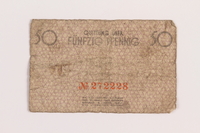
Łódź ghetto scrip, 50 pfennig note, acquired by a Polish Jewish survivor
Object
Łódź (Litzmannstadt) ghetto scrip, 50 pfennig note, acquired by Benjamin Miedzyrzecki, who lived in Łódź, Poland, circa February-May 1945, after leaving Warsaw following the liberation of both cities in early 1945. Scrip was issued by the Jewish Council as payment for work or as subsidy in the German-controlled ghetto from May 15, 1940 until the ghetto was liquidated in spring 1944. Benjamin, his parents Israel and Rivka, and siblings Stela, Mordecai, and Genia lived in Warsaw during the German occupation which began in September 1939. Benjamin escaped to eastern Poland, then returned in December and joined the resistance. They were forced into the Jewish ghetto in October 1940, and Benjamin was a forced laborer, working outside the ghetto cleaning destroyed buildings. He smuggled people in and out of the ghetto for the resistance. In July 1942, the Germans began mass deportations of Jews to Treblinka killing center. Israel was arrested and bribed a policeman to release him. Stela and her husband Yitzhak Blachowicz were sent to Treblinka. In fall 1942, Benjamin meet Feigele (Vladka) Peltel, a courier for the underground, when he smuggled her out of the ghetto. They went into hiding on the Aryan side of Warsaw. He persuaded his family to join him. In summer 1943, Mordecai was killed by the Germans. The ghetto was liquidated that summer after the failed Warsaw Ghetto Uprising. In August 1944, Soviet troops reached the Vistula River near Warsaw and the Polish Home Army rebelled against the German occupation. Israel, Rivka, and Genia were separated from Benjamin. The Uprising was crushed and the city destroyed by the Germans in October 1944. Benjamin was reunited with his family after Warsaw was liberated on January 16, 1945.They lived in Warsaw, where Israel insisted that Benjamin marry Feigele. The family went to Łódź and, after the war ended in early May 1945, left for Munich, Germany. In May 1946, Benjamin and Feigele sailed for America. Genia emigrated to Palestine in 1946 and Israel and Rivka joined her in 1947.
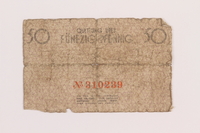
Łódź ghetto scrip, 50 pfennig note, acquired by a Polish Jewish survivor
Object
Łódź (Litzmannstadt) ghetto scrip, 50 pfennig note, acquired by Benjamin Miedzyrzecki, who lived in Łódź, Poland, circa February-May 1945, after leaving Warsaw following the liberation of both cities in early 1945. Scrip was issued by the Jewish Council as payment for work or as subsidy in the German-controlled ghetto from May 15, 1940 until the ghetto was liquidated in spring 1944. Benjamin, his parents Israel and Rivka, and siblings Stela, Mordecai, and Genia lived in Warsaw during the German occupation which began in September 1939. Benjamin escaped to eastern Poland, then returned in December and joined the resistance. They were forced into the Jewish ghetto in October 1940, and Benjamin was a forced laborer, working outside the ghetto cleaning destroyed buildings. He smuggled people in and out of the ghetto for the resistance. In July 1942, the Germans began mass deportations of Jews to Treblinka killing center. Israel was arrested and bribed a policeman to release him. Stela and her husband Yitzhak Blachowicz were sent to Treblinka. In fall 1942, Benjamin meet Feigele (Vladka) Peltel, a courier for the underground, when he smuggled her out of the ghetto. They went into hiding on the Aryan side of Warsaw. He persuaded his family to join him. In summer 1943, Mordecai was killed by the Germans. The ghetto was liquidated that summer after the failed Warsaw Ghetto Uprising. In August 1944, Soviet troops reached the Vistula River near Warsaw and the Polish Home Army rebelled against the German occupation. Israel, Rivka, and Genia were separated from Benjamin. The Uprising was crushed and the city destroyed by the Germans in October 1944. Benjamin was reunited with his family after Warsaw was liberated on January 16, 1945.They lived in Warsaw, where Israel insisted that Benjamin marry Feigele. The family went to Łódź and, after the war ended in early May 1945, left for Munich, Germany. In May 1946, Benjamin and Feigele sailed for America. Genia emigrated to Palestine in 1946 and Israel and Rivka joined her in 1947.
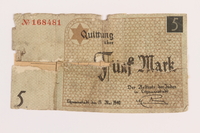
Łódź ghetto scrip, 5 mark note, acquired by a Polish Jewish survivor
Object
Łódź (Litzmannstadt) ghetto scrip, 5 mark note, acquired by Benjamin Miedzyrzecki, who lived in Łódź, Poland, circa February-May 1945, after leaving Warsaw following the liberation of both cities in early 1945. Scrip was issued by the Jewish Council as payment for work or as subsidy in the German-controlled ghetto from May 15, 1940 until the ghetto was liquidated in spring 1944. Benjamin, his parents Israel and Rivka, and siblings Stela, Mordecai, and Genia lived in Warsaw during the German occupation which began in September 1939. Benjamin escaped to eastern Poland, then returned in December and joined the resistance. They were forced into the Jewish ghetto in October 1940, and Benjamin was a forced laborer, working outside the ghetto cleaning destroyed buildings. He smuggled people in and out of the ghetto for the resistance. In July 1942, the Germans began mass deportations of Jews to Treblinka killing center. Israel was arrested and bribed a policeman to release him. Stela and her husband Yitzhak Blachowicz were sent to Treblinka. In fall 1942, Benjamin meet Feigele (Vladka) Peltel, a courier for the underground, when he smuggled her out of the ghetto. They went into hiding on the Aryan side of Warsaw. He persuaded his family to join him. In summer 1943, Mordecai was killed by the Germans. The ghetto was liquidated that summer after the failed Warsaw Ghetto Uprising. In August 1944, Soviet troops reached the Vistula River near Warsaw and the Polish Home Army rebelled against the German occupation. Israel, Rivka, and Genia were separated from Benjamin. The Uprising was crushed and the city destroyed by the Germans in October 1944. Benjamin was reunited with his family after Warsaw was liberated on January 16, 1945.They lived in Warsaw, where Israel insisted that Benjamin marry Feigele. The family went to Łódź and, after the war ended in early May 1945, left for Munich, Germany. In May 1946, Benjamin and Feigele sailed for America. Genia emigrated to Palestine in 1946 and Israel and Rivka joined her in 1947.
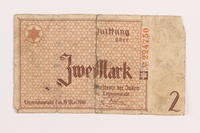
Łódź ghetto scrip, 2 mark note, acquired by a Polish Jewish survivor
Object
Łódź (Litzmannstadt) ghetto scrip, 2 mark note, acquired by Benjamin Miedzyrzecki, who lived in Łódź, Poland, circa February-May 1945, after leaving Warsaw following the liberation of both cities in early 1945. Scrip was issued by the Jewish Council as payment for work or as subsidy in the German-controlled ghetto from May 15, 1940 until the ghetto was liquidated in spring 1944. Benjamin, his parents Israel and Rivka, and siblings Stela, Mordecai, and Genia lived in Warsaw during the German occupation which began in September 1939. Benjamin escaped to eastern Poland, then returned in December and joined the resistance. They were forced into the Jewish ghetto in October 1940, and Benjamin was a forced laborer, working outside the ghetto cleaning destroyed buildings. He smuggled people in and out of the ghetto for the resistance. In July 1942, the Germans began mass deportations of Jews to Treblinka killing center. Israel was arrested and bribed a policeman to release him. Stela and her husband Yitzhak Blachowicz were sent to Treblinka. In fall 1942, Benjamin meet Feigele (Vladka) Peltel, a courier for the underground, when he smuggled her out of the ghetto. They went into hiding on the Aryan side of Warsaw. He persuaded his family to join him. In summer 1943, Mordecai was killed by the Germans. The ghetto was liquidated that summer after the failed Warsaw Ghetto Uprising. In August 1944, Soviet troops reached the Vistula River near Warsaw and the Polish Home Army rebelled against the German occupation. Israel, Rivka, and Genia were separated from Benjamin. The Uprising was crushed and the city destroyed by the Germans in October 1944. Benjamin was reunited with his family after Warsaw was liberated on January 16, 1945.They lived in Warsaw, where Israel insisted that Benjamin marry Feigele. The family went to Łódź and, after the war ended in early May 1945, left for Munich, Germany. In May 1946, Benjamin and Feigele sailed for America. Genia emigrated to Palestine in 1946 and Israel and Rivka joined her in 1947.
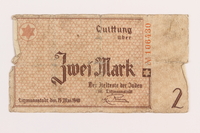
Łódź ghetto scrip, 2 mark note, acquired by a Polish Jewish survivor
Object
Łódź (Litzmannstadt) ghetto scrip, 2 mark note, acquired by Benjamin Miedzyrzecki, who moved to Łódź from Warsaw, both liberated in early 1945, in the final months of the war, circa February-May 1945. The scrip was was issued in the German-controlled ghetto from May 15, 1940 until the ghetto was liquidated in spring 1944. When the Germans transferred Jews to the ghetto, all currency was confiscated in exchange for Quittungen [receipts.] The Jewish Council also issued it to forced laborers and certain classes of people. It could be spent only inside the ghetto. When Germany invaded Poland on September 1, 1939, Benjamin lived in Warsaw with his parents, Israel and Rivka, and siblings Stela, Mordecai, and . He fled to eastern Poland, then returned in December and joined the Jewish resistance. After the Warsaw ghetto was established in October 1940, Benjamin was a forced laborer, working daily outside the ghetto cleaning destroyed buildings. He smuggled people in and out of the ghetto for the resistance. In July 1942, the Germans began mass deportations of Jews to Treblinka killing center. Benjamin’s father Israel was arrested and bribed a policeman to release him. His sister Stela and her husband Yitzhak Blachowicz were sent to Treblinka. In fall 1942, Benjamin meet Feigele (Vladka) Peltel, a courier for the underground, when he smuggled her out of the ghetto. Benjamin escaped and went into hiding on the Aryan side of Warsaw with Feigele. He eventually persuaded his family to join him. In summer 1943, he gave his brother false papers to leave Poland, but Mordecai was shot and killed. The ghetto was liquidated that summer after the failed Warsaw Ghetto Uprising. In August 1944, Soviet troops reached the Vistula River near Warsaw and the Polish Home Army rebelled against the German occupation. Israel, Rivka, and Genia were separated from Benjamin. The Uprising was crushed and the city destroyed by the Germans in October 1944. Benjamin received a message from Israel and found them after Warsaw was liberated on January 16, 1945. The family returned to Warsaw where Israel insisted that Benjamin marry Feigele. The family left for Łódź and were there when the war ended in early May 1945. They then left for Munich, Germany. In May 1946, Benjamin and Feigele sailed for America. Genia emigrated to Israel in 1946 and Israel and Rivka joined her in 1947.
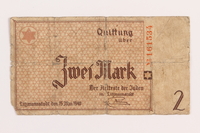
Łódź ghetto scrip, 2 mark note, acquired by a Polish Jewish survivor
Object
Łódź (Litzmannstadt) ghetto scrip, 2 mark note, acquired by Benjamin Miedzyrzecki, who lived in Łódź, Poland, circa February-May 1945, after leaving Warsaw following the liberation of both cities in early 1945. Scrip was issued by the Jewish Council as payment for work or as subsidy in the German-controlled ghetto from May 15, 1940 until the ghetto was liquidated in spring 1944. Benjamin, his parents Israel and Rivka, and siblings Stela, Mordecai, and Genia lived in Warsaw during the German occupation which began in September 1939. Benjamin escaped to eastern Poland, then returned in December and joined the resistance. They were forced into the Jewish ghetto in October 1940, and Benjamin was a forced laborer, working outside the ghetto cleaning destroyed buildings. He smuggled people in and out of the ghetto for the resistance. In July 1942, the Germans began mass deportations of Jews to Treblinka killing center. Israel was arrested and bribed a policeman to release him. Stela and her husband Yitzhak Blachowicz were sent to Treblinka. In fall 1942, Benjamin meet Feigele (Vladka) Peltel, a courier for the underground, when he smuggled her out of the ghetto. They went into hiding on the Aryan side of Warsaw. He persuaded his family to join him. In summer 1943, Mordecai was killed by the Germans. The ghetto was liquidated that summer after the failed Warsaw Ghetto Uprising. In August 1944, Soviet troops reached the Vistula River near Warsaw and the Polish Home Army rebelled against the German occupation. Israel, Rivka, and Genia were separated from Benjamin. The Uprising was crushed and the city destroyed by the Germans in October 1944. Benjamin was reunited with his family after Warsaw was liberated on January 16, 1945.They lived in Warsaw, where Israel insisted that Benjamin marry Feigele. The family went to Łódź and, after the war ended in early May 1945, left for Munich, Germany. In May 1946, Benjamin and Feigele sailed for America. Genia emigrated to Palestine in 1946 and Israel and Rivka joined her in 1947.



